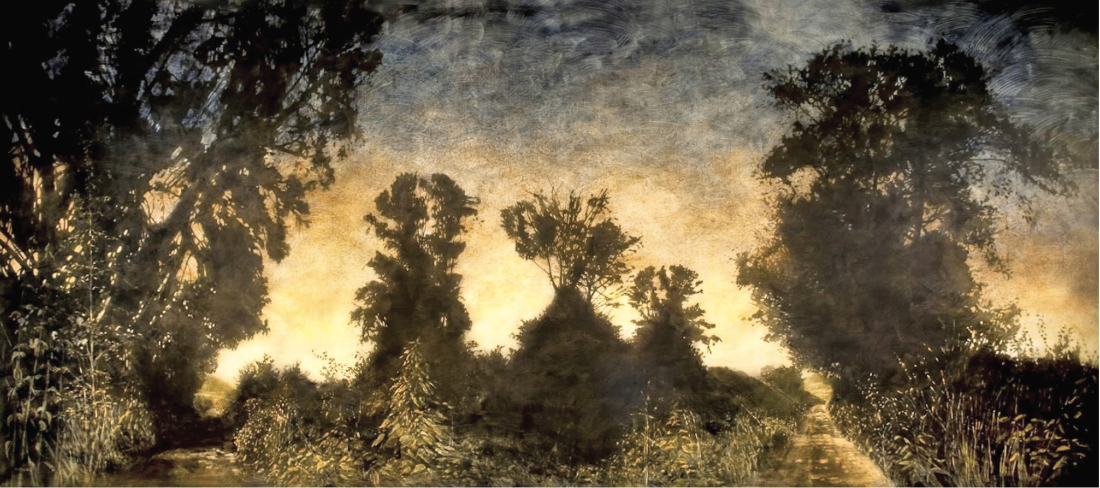Stephen Hutchings
Walk into the large gallery space that holds eight landscape works by Ottawa-based artist Stephen Hutchings, and it’s hard not to be struck by their immediate, almost overwhelming beauty. At first it seems to be beauty in a very traditional sense. There’s a hint of Old Master painting here: the monumental scale, the gentle golden haze, the light that recalls the American luminists, the tinge of German romantic melancholy, the faint aura of immanence.
But “Landscapes for the End of Time,” which originated at Calgary’s Glenbow Museum in 2011 and showed at the Winnipeg Art Gallery from May 10 to August 5, 2012, is actually a series of layered tensions. Hutchings explores paradoxes of the scientific and the spiritual, the transitory and the permanent, the real and the ideal. As with the musical piece that informs these landscapes, French composer Olivier Messiaen’s Quartet for the End of Time, this is beauty poised between darkness and light.
Using landscape to question the relation between painting and photography, Hutchings combines aspects of both media to end up with a self-conscious 21st-century version of Pictorialism. These works could come off as very painterly paintings. The texture is worked-over, with marks and daubs that suggest an artist’s hand. The surface sometimes suggests the dark, crackled glaze of old canvases. But there are also signs that make reference to photography. Hill has the sunlit haze of an overexposed outdoor shot. Abyss looks like a reverse negative image. Branch uses the cropped, close-up composition associated with photos, though it is blown up to an improbable size. All of the works fall within a colour range that suggests the sepia tones and hand-tinted hues of 19th- century photography.
Hutchings first develops his images through technological means. Taking a landscape photograph, he uses Photoshop and a series of “digital sketches” to pare it down, double it up or change it. In Roads, for example, he gives a country lane a mirror image, moving the shot’s Realism into the territory of the uncanny. These manipulated photo images are then projected onto a gessoed canvas and turned into large-scale charcoal sketches. Hutchings delineates forms by drawing and then erasing. Colour comes through multiple layers of thin glaze and, again, desired tones are achieved through a process that involves both building up and scraping away. He describes it as a “push and pull” process, which is how he reaches that twilit equilibrium between light and dark.

Stephen Hutchings, Roads (Messiaen #1), 2012, oil and charcoal on canvas, 8 x 19’. Collection of the Winnipeg Art Gallery, gift from the artist.
It’s a tricky balance. Some of the works are so lovely that they can head towards the placid prettiness of kitsch, but they veer off at the last moment, undercut by a deliberately odd placement, a scruffy detail, or a looming darkness of mood.
Mood is crucial in establishing the link to notions of the sublime. In Sky, the huge scale and sense of thundering threat call up the sublime landscape paintings of the late-18th and early-19th centuries. With plunging waterfalls, wild seas and snowstorms in the Alps, the romantic sublime reflected a fusion of terror and beauty in the face of nature, what the philosopher Edmund Burke, quoting William Blake, defined as “portions of eternity too great for the eye of man.”
Hutchings also calls up the Christian sublime in his reference to Olivier Messiaen’s Quartet. (The Gryphon Trio and clarinetist James Campbell performed this music at both the Glenbow and the WAG.) Composed when Messiaen was being held in a German prison camp in 1940 and first performed by Messiaen and three fellow prisoners on January 15, 1941, Quartet imagines “an end of time” in which the finite human world is subsumed into the infinite divine. A devout Catholic, Messiaen saw in the horrors of the Second World War an echo of the apocalyptic Book of Revelation.
The romantic and Christian sublime both require a perfect fusion of the subjective and objective, however, and the tensions in Hutchings’s work resist this. He explores the tropes of romantic painting, from tumultuous clouds to sheltering trees, in works whose elemental titles suggest the eternal and the universal—Grove, Tree, Hill, Sky. But the instantaneity and specificity of photography persist in small traces—an odd angle, an unlikely composition, a prickly detail. Hutchings makes reference to a spiritual dimension—celestial skies that radiate God-like light—but withholds final Communion. He holds out distant visions of transcendent landscapes while acknowledging the burden of modernist separateness and self-consciousness. If 19th-century Romanticism expressed a yearning for the pantheistic power of nature, “Landscapes for the End of Time” expresses something else—a yearning for yearning, perhaps. What we feel in front of these works is loss, a melancholy sense that it is now impossible to experience nature without a simultaneous awareness of the conventions of its representation. ❚
“Stephen Hutchings: Landscapes for the End of Time” was exhibited at the Winnipeg Art Gallery from May 10 to August 5, 2012.
Winnipeg journalist Alison Gillmor writes a visual arts column for the Winnipeg Free Press.

